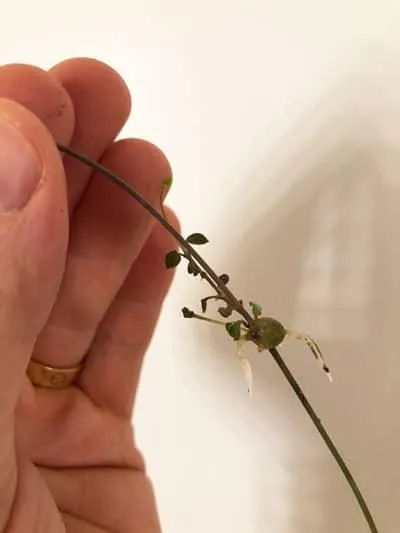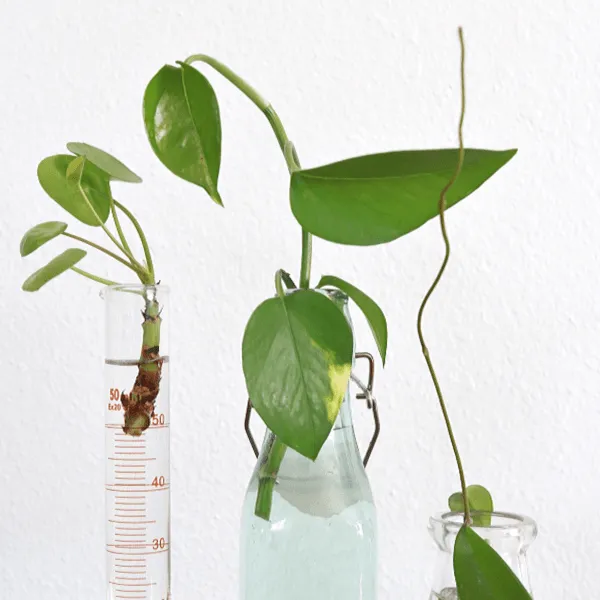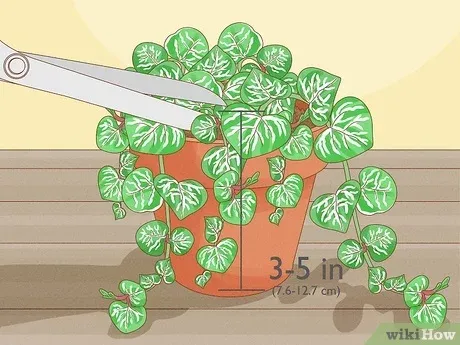
How to Propagate String of Hearts Plants: A Step-by-Step Butterfly Method
Everything You Need to Know About Propagating String of Hearts Butterfly Plants
Have you ever seen those gorgeous trails of heart-shaped leaves and been fascinated by the softly floating flowers? Known as string of hearts or butterfly plants, these vines are simply stunning additions to any garden. Their delicate beauty has made them hugely popular houseplants too. If you’re eager to grow your own string of hearts but don’t know where to begin, this comprehensive guide covers everything from care requirements to propagation methods.
String of Hearts Plant Basics
String of hearts, scientifically called Ceropegia woodii, is a flowering vine native to South Africa. As a succulent plant, it stores water in its fleshy leaves and stems, allowing it to thrive in dry indoor conditions. Its heart-shaped leaves form graceful chains that can grow several feet long if given space to trail. Beautiful dangling flowers also bloom periodically in shades of white, pink or red.
These plants prefer bright, indirect light and well-draining soil. Water them just enough to keep the soil slightly moist but not soggy. They’re quite hardy and adapt well to a variety of care routines. Some people find string of hearts a bit finicky at first until you get the hanging of their needs. But with a little trial and error, you’ll have these beauties thriving for years.
Propagating Through Cuttings
While you can purchase string of hearts starter plants, propagating from cuttings is an affordable and easy way to increase your collection. Here are the basic steps:
- Take 4-6 inch stem cuttings by snipping leaves and stems from the mother plant using clean pruners or scissors.
- Remove lower leaves, leaving the top few intact. This concentrates the plant’s energy where new roots will form.
- Allow the cut end to dry and callous over for a few days.
- Plant the cuttings in well-draining potting soil, pressing gently so about half the stem is buried.
- Mist the soil daily and keep it consistently moist until roots emerge, usually 2-4 weeks. Then you can water as needed.
Within a few months, you’ll see roots and new growth developing. Soon the cuttings will be full, trailing plants of their own. It’s remarkably simple and from my experience, string of hearts propagates easily with great success rates.

The Butterfly Method
An ingenious propagation technique lets you multiply your string of hearts collection exponentially – it’s called the butterfly method. Here’s how it works:
- Take stem cuttings as above but leave a few extra leaves attached below the top ones.
- Lay the stem horizontally on moist soil rather than planting vertically.
- Within a few weeks, you’ll see roots forming from the lower leaves where they touch the soil.
- Once established, each leaf will sprout its own plant! So one cutting effectively “multiplies” into several new starts.
The name comes from how the leaves resembling butterfly wings appear to “emerge” from the original stem. I kid you not, it’s like magic watching new plants sprout all along a single cutting. Increased sunlight and consistent moisture seem key for success with this method.
Proper Care For Thriving Strings of Hearts
While resilient, string of hearts do best with some TLC. Here are my top care tips to keep your vines looking fab:
- Water just enough to prevent leaves from wrinkling. Let the soil dry slightly between waterings.
- Feed monthly in spring and summer with a diluted liquid fertilizer for lush new growth.
- Repot annually in early spring using a well-draining potting mix. Go up just one size to avoid rootbound plants.
- Prune off any brown or shriveled sections to maintain an attractive shape.
- Rotate the pot weekly so all sides receive equal light exposure.
- Bring indoors before first frost and provide bright, indirect winter light by a sunny window.
Adopt these care practices and your string of hearts will reward you with long, fuller vines and colorful blooms season after season. Let me know if you have any other questions! Propagation is truly the way to build an impressive collection without breaking the bank.
Dealing With Pests and Problems
Most string of hearts grown indoors will encounter few issues. But critters may strike outdoor plants. Watch out for:

- Mealybugs: Fluffy white insects suck plant juices. Wipe leaves with alcohol or treat with neem oil.
- Spider mites: Tiny spiders leave stippling on leaves. Wash affected areas with water and spray plant regularly.
- Overwatering: Soggy soil causes rotted stems and yellow leaves. Let soil dry between waterings.
- Underwatering: Wrinkled leaves point to too little H2O. Water immediately when dry 2 knuckles deep.
With a little TLC and pest prevention, your string of hearts should stay happy and healthy for years to come. Let me know if you have any other questions! Propagation is truly the way to rock your garden.
Frequently Asked Questions
Here are answers to some common queries from gardeners new to string of hearts:
- Can I grow these outdoors in my zone? Yes, in warm temperate or tropical areas string of hearts can be grown outdoors year-round as a groundcover or trained onto a trellis.
- How long until cuttings root? Most of mine have rooted within 3-4 weeks but it can vary. Keep the soil consistently moist until you see new growth.
- Can I start cuttings in water? You sure can! Just change the water every few days. However, success rates tend to be higher starting directly in soil.
- Will cutting damage the mother plant? Nah, string of hearts is very resilient. Pruning encourages bushier growth. Just be sure not to take more than 1/3 of the plant at once.
- Do they need full sun? While they tolerate lower light quite well, string of hearts really thrive and bloom best with at least 6 hours of bright, indirect sun daily.
I hope this guide has answered your propagation questions and provided lots of helpful string of hearts care tips. Let me know if you have any other questions! Wishing you green thumbs as you start growing your own gorgeous vines.
Propagating String of Hearts Butterfly Method
| Step | Activity | Time Required |
|---|---|---|
| 1 | Choose a butterfly bush plant and locate new growth | 5 minutes |
| 2 | Select 8-10 stems that are 4-6 inches long | 5 minutes |
| 3 | Remove leaves from the lower portions of the stems | 10 minutes |
| 4 | Make a single horizontal cut on each stem just below a node | 5 minutes |
| 5 | Dip the stems in rooting hormone and insert into the propagation medium | 10 minutes |
| 6 | Mist the propagation area daily and ensure the medium stays moist | 5 minutes daily |
| 7 | New growth should be visible within 4-6 weeks | 4-6 weeks |
FAQ
-
What is the propagating string of hearts butterfly method?
Basically, the propagating string of hearts butterfly method is a way to create butterfly-shaped designs made up of linked paper hearts. You start with a single heart shape and fold it to add legs that will attach it to the next heart and so on. It’s pretty cool how one piece leads to another to make a little string of hearts!

-
How does it work?
Each heart gets folded in half and little tabs are cut to act as legs that stick out on the sides. These tabs allow you to link one heart to the next by sticking the tabs of one heart through the bottom center holes of the next. You continue adding hearts this way until your “string” is as long as you want it to be. At that point, you attach the ends together so the string forms a loop like a butterfly.
-
What kind of paper do I need?
Pretty much any kind of paper will work as long as it’s thin enough to fold without tearing. Construction paper, origami paper, gift wrapping paper – those tend to work nicely. Thicker cardstock might be tougher to fold cleanly into hearts. You can use solid colors or cute prints – it’s up to your creative vision!
-
How many hearts should I make?
There’s no set number – make as long of a “string” as you like. Most people seem to stop at around 8-12 hearts. Any longer and it can get unwieldy. You also don’t want to skimp – less than 5 or 6 and it may not look very “butterfly-like.” Perhaps try making a sample with different amounts to see what looks best to you!
-
Can I decorate the individual hearts?
Definitely! You’re encouraged to get creative and customize each heart if you want. Things like glueing on googly eyes, glitter, sequins, gems, sticker accents and more can give each heart its own personality. You can also add a pattern by alternating colors heart to heart. The decorations are purely optional but they do make the finished design more festive!
-
What can I do with the finished butterfly?
Lots of options! Hang it from the ceiling as a mobile, display it on a table or mantel, tie it to a gift package as a decoration. Or you could even incorporate the folded heart shapes into a collage or scrapbook page as a fun design element. The propagating string of hearts butterfly makes a cute low-cost craft and unique homemade gift too.

-
Any tips for success?
Take your time folding the hearts neatly and making clean cuts for the tabs. It’s also important to push the tabs all the way through the center holes so the “string” holds together well. Use a dab of glue if the tabs won’t stay put. Having the right kind of paper also kind of makes a difference. With a bit of patience you’re sure to end up with a pretty little paper butterfly!